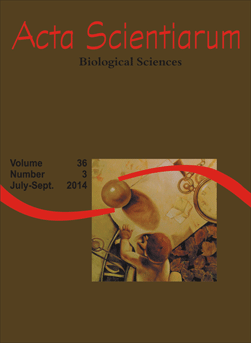<b>Distribution and structural aspects of extrafloral nectaries in leaves of <i>Pyrostegia venusta</i> (Bignoniaceae)
Abstract
Pyrostegia venusta (the orange trumpet or commoly called cipó-de-São-João in Brazil), a medicinal plant that grows with other plants, has an ecological importance due to the presence of nectaries on the leaves. The aim of this work was to study structural and histochemical aspects and the distribution of extrafloral nectaries (ENFs) in P. venusta leaves. Young leaves were collected, fixed and processed by usual techniques, and studied under light microscopy and scanning electron microscopy. Analyses showed that the extrafloral nectaries are dispersed throughout the leaf, with concentrations mainly in the basal third section. Nectaries lie in epidermal depressions and can be found in abaxial and adaxial leaf blades. Their morphology may be characterized macroscopically by achlorophyllous halos and microscopically as structures consisting of a short pedicel, oval multicellular head, covered by a thin cuticular layer with a secretory pole. Reducing sugars, neutral polysaccharides, proteins, starch and phenolic compounds were detected in extrafloral nectaries.
Downloads
DECLARATION OF ORIGINALITY AND COPYRIGHTS
I Declare that current article is original and has not been submitted for publication, in part or in whole, to any other national or international journal.
The copyrights belong exclusively to the authors. Published content is licensed under Creative Commons Attribution 4.0 (CC BY 4.0) guidelines, which allows sharing (copy and distribution of the material in any medium or format) and adaptation (remix, transform, and build upon the material) for any purpose, even commercially, under the terms of attribution.
Read this link for further information on how to use CC BY 4.0 properly.












1.png)




3.png)













